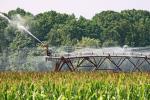H2020 agROBOfood Project: Business-oriented support for the European robotics and agri-food sector, towards a network of digital innovation centers in robotics
- Type Project
- Status Signed
- Execution 2019 -2024
- Assigned Budget 15.999.768,00 €
- Scope Europeo
- Main source of financing Horizon 2020
- Project website Proyecto agROBOfood
The European agri-food sector faces a major challenge: ensuring environmentally friendly production at lower costs and with labor shortages. The solution requires technological modernization of agriculture, and robotics can play an important role. The agROBOfood project, a consortium of 39 partners, aims to accelerate the sector's digital transformation through the adoption of robotics technologies. To drive the adoption of robotics solutions, it will establish a sustainable network of Digital Innovation Hubs (DIHs). At the heart of the project are the Innovation Experiments (IEs), which will be organized and supervised by the DIHs. The European robotics community will be involved throughout the project to ensure maximum synergy. This will maximize the return on investments resulting from the digital transformation of the agri-food sector.
Situation after the first year After year 1 of the project, the current situation of the agROBOfood project can be summarized as: Network building with the implementation of the regional approach with regional and national contact points, establishment of procedures for network membership, interest from them through an open call and development of a self-assessment test for DIH/CC. Visibility of the network through the activation of all our communication tools such as the website, social media, newsletter and Basecamp.
We also organize or host (digital) meetings and contribute to the international community with publications and presentations, and participate in RODIN, OpenDEI, CEMA, ROS, EU-Robotics, and EU networks. Start by loading the network with ecosystem, technical, and commercial services. These are provided to the IIE. The DIHs/CCs in the agROBOfood network began learning from each other's approaches. To support this, we conducted a 'white spot' analysis. Consider contributions to trainings, platforms, open data, standardization, and specific DIH/CC needs. To demonstrate and test the robotics needs for agri-food systems and the agROBOfood network, we have already worked on seven Innovation Experiments that have a DIH mentor.
DIH/CC may present showcases on the website. To make the network sustainable, we begin by looking at other examples, the field of existing organizations interested in agri-food robotics, and to understand the specific nature of the agROBOfood network. We benefit from cooperation with the Industrial Advisory Council, RODIN, and SmartAgriHub experiences.
The agROBOfood project (grant number 825395) will develop a pan-European network of Digital Innovation Hubs (DIHs) and Competence Centers to stimulate the implementation of high-tech robotics concepts for the agri-food sector and demonstrate their applicability in practical circumstances. To overcome the fragmentation of organizations working on digitalization in Europe, the EU promotes the concept of Digital Innovation Hubs and related Competence Centers.
DIHs are one-stop shops based on technological infrastructures (Centers of Competence) and provide access to the latest knowledge, experience, and technology to support their clients in the pilot phase, testing, and experimentation with digital innovations. DIHs also provide business and financial support to implement these innovations, if necessary, throughout the entire value chain. Since proximity is considered crucial, they act as a first regional point of contact, a gateway, and strengthen the innovation ecosystem. A key success factor is that agROBOfood already covers 24 European countries through the 39 consortium partners and the 41 associated partners at the start of the project. agROBOfood works in Europe with seven Regional Cluster Coordinators, tasked with establishing a DIH in robotics per country. This allows us to address differences in the degree of organization and are able to work with one-stop shops. The network is expected to grow during the project and be maintained after the agROBOfood project ends. A prerequisite is that network members be proactive and willing to learn from each other to professionalize services for clients.
Since agROBOfood is not the only DIH network in digitalization, we are in contact with CSA-RODIN DIH2 partners Trinity, RIMA, and DIH-Hero, and with AGRI-related projects such as SmartAgriHub and IoF2020. The agROBOfood network will be able to offer a variety of ecosystem, technical, and business services. We will utilize these core concepts and professionalize our agROBOfood partners to be able to provide these services in the field of robotic expertise to their customers. We will incentivize all DIHs to be able to offer the full suite of services to their customers. We support them through targeted training and education, and when necessary, we can develop specific services dedicated to robots. In essence, we will infuse the agROBOfood network with knowledge and expertise in a variety of services.
To demonstrate the value of the agROBOfood network and robotics in the agri-food system, we work with Innovation Experiments (IE) and Industrial Challenges (IC). In an IE, a small group of SMEs, startups, and industrial partners work together across borders. Based on a relatively mature technology, they develop and demonstrate robotic solutions. They also experiment with agROBOfood services and end-users. We started with seven IE and will expand the IE and IC with three open calls, with a total budget of €8 million. The first call will be launched in March 2020.
agROBOfood is dedicated to accelerating the digital transformation of the European agri-food sector through the adoption of robotics technologies. It will consolidate, expand, and strengthen the current ecosystem by establishing a sustainable network of robotics providers. This will boost the adoption of robotics solutions by the agri-food sector: a huge challenge that requires an inclusive approach involving all relevant European stakeholders. The agROBOfood consortium has 39 partners, led by Wageningen University & Research and other core partners from previous key projects such as IoF2020, ROBOTT-NET, PicknPack, and I4MS, to leverage the ecosystem established in those projects.
The heart of the project are the Innovation Experiments (IEs), organized and monitored by the DIHs. In each of the seven regional clusters, an initial IE will demonstrate robotics innovations in the agri-food sector in a way that ensures replicability across Europe, broad adoption, and sustainability of the DIH network. agROBOfood will work closely with the European robotics community, ensuring synergistic effects with initiatives such as EU-Robotics. This will maximize the return on European investments, including private capital, in the digital transformation of the agri-food industry. A key instrument in achieving this goal is the Industrial Advisory Board. They will provide strategic guidance and also define priorities for the selection of solutions to be funded.
The 8 MEUR open calls will attract additional innovation experiments (12) and industrial challenges (8). These will widen the network and ensure that the vast technological developments and emerging challenges of the agri-food sector are incorporated into the DIHs’ service portfolio. Through its inclusive structure and ambitious objectives, agROBOfood aims to unite the entire European ecosystem; connecting the dots in a way that ensures the effective adoption of robotic technologies in the European agri-food sector.
At the strategic level, agROBOfood is contributing to the Multi-Year Roadmap for Robotics. In these discussions, we contribute the vision that agri-food network systems will be more diverse, flexible, responsive, and transparent, and that stakeholders should be able to choose robotic solutions that can cooperate in an environment where service providers and humans also work. To increase the deployment of robotics in the agri-food sector, agROBOfood's goal is to engage end-users and SMEs by supporting innovation experiments and market-ready robotic solutions across all regions using existing channels and influencers, such as cooperatives, advisors, CCs, regional clusters, and DIHs. In Year 1 of agROBOfood, we focused on strengthening and expanding the network of existing DIHs and CCs, enabling them to reach more users.
The call for proposals attracts new IH/CC, SMEs, and startups. agROBOFood focuses more on SMEs than on reaching farmers. Mutual learning and cross-border approaches are being tested at the IIE and in the search for white spots. All of this is supported by our communication and dissemination strategy. The impact of communication activities is already significant. To create impact through platforms, CEMA organized dedicated debates, EU-Robotics is integrated into RODIN activities, and members of the agROBOfood Industrial Advisory Board have become members of the agri-food robotics thematic group. Fraunhofer and TU-Delft actively stimulated the creation of a working group dedicated to ROS agriculture. The impact for the European robotics industry is to communicate at all levels the need for and added value of the agROBOfood network. The triple helix approaches are unique in the European market.
Cooperation between large-scale industry, SMEs, start-ups, NGOs, and knowledge institutions is stimulated by our regional approach to IHL/CC. Large-scale industry participates in the Industrial Advisory Council. The communication strategy has been implemented. Demonstration, best practice, and training activities should be enhanced in the upcoming reporting periods.
- STICHTING WAGENINGEN RESEARCH (WR)






